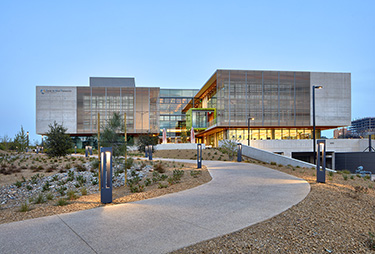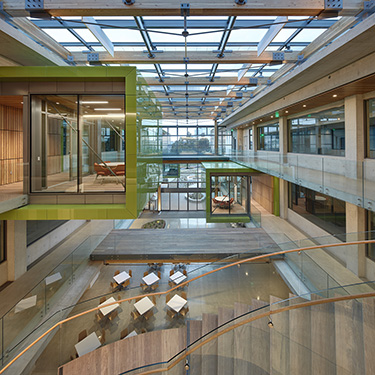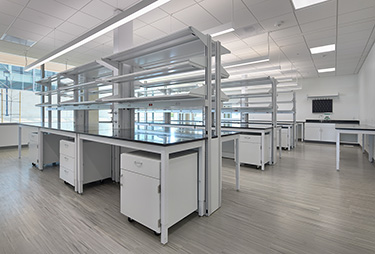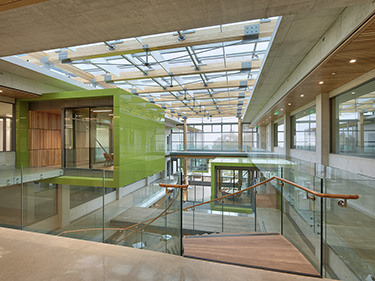|
Subscribe / Renew |
|
|
Contact Us |
|
| ► Subscribe to our Free Weekly Newsletter | |
| home | Welcome, sign in or click here to subscribe. | login |
Construction
| |
 |
November 21, 2019
New lab building anchors UC San Diego research park
Perkins and Will

Bussard
|
Universities always have a bottom-line question at hand: how do they remain relevant and competitive?
Whether enhancing and expanding course offerings, campus programming or research initiatives to attract top talent, adaptation is key.
For research universities, however, adaptation is even more critical. Research runs on novel thinking, so these universities have a different bottom line: how do they creatively drive forward innovation and discovery?
For all this adaptation, what doesn’t always adapt quickly is architecture and building design. Their roles in positioning universities at the forefront of the next era of research and learning must not be overlooked, though.
This means moving beyond labs as traditional pinnacles of research and considering how to program spaces to convey research-oriented values — how they might spark ideas or yield breakthroughs.
By integrating innovation and discovery throughout buildings and its built environment, a university can leverage architecture and design for effective placemaking that guides the entire campus in its vision for the future.
Placemaking at UCSD
In 2019, when it was time for University of California San Diego to usher in a new era of engagement and refresh the public image for its campus, it was also time to change how the university approached placemaking through thoughtful building design and architecture.
Historically a commuter school, UCSD’s enrollment has grown rapidly, now nearing 40,000 students interested in its research-centered mission. Receiving more than $1.1 billion in government research grants, UCSD attracts researchers seeking support to solve long-term problems. Providing the right spaces to continue fueling scientific research and breakthroughs is a challenge for the university’s flourishing research arm.
Due to UCSD’s emphasis on cross-disciplinary academics and research, a partnership across design teams and projects made sense. From years of experience delivering higher education and life science projects for Pacific Northwest research universities like the University of Washington, Perkins and Will had the ability to navigate the specific needs of higher education clients to develop versatile campus facilities that serve as beacons of change and placemaking on campus.
A research accelerator
As part of a master plan to foster a welcoming tone with the public and community around campus, UCSD is reshaping the gateway of its campus. Supplementing this work is an extension of the campus across the San Diego Freeway, known as Science Research Park. Through partnerships in this district, university developments will transform the university beyond its campus, positioning it as a hub of innovative research among San Diego’s thriving life sciences industry.
Anchoring this transformation is a new initiative between UCSD and BioMed Realty: a new building called the Center for Novel Therapeutics, a 137,500-square-foot, research accelerator facility. Located within UCSD’s Science Research Park, the Center for Novel Therapeutics is surrounded by academic researchers, health care institutions and life science and technology companies, including the world-renowned Moores Cancer Center and private-sector companies translating research into real-world applications for cancer patients.
Building design and structure were critical elements for this hallmark development at the heart of a university-wide transformation to succeed. Perkins and Will Seattle relied on three pillars to leverage architecture and design, and establish a sense of place.
Collaboration is key
Collaboration outside traditional university structures is the future of scientific advancement. With organic interactions and flexible work environments encouraged through design choices, researchers and scientists are galvanized around a space centering learning and collaboration.
Conceptualized as a research accelerator, the Center for Novel Therapeutics’ floors are stacked to encourage junior researchers and senior scientists to converge to solve problems.
Research pods prevent silos, furthering spontaneous collaboration between researchers of all levels. These pods, programmed with varying layouts, act as a “living room,” allowing for informal meetings and connections at every floor level. These meetings often ignite groundbreaking ideas, and the building’s interconnectivity allows for a smooth transition from collective brainstorming to putting those ideas into practice, establishing a space for breakthroughs and new ideas to unite and build off each other.
Flow of information
Design choices around information flow further fuel the collaborative processes. Not only do cantilevered staircases inside the building allow for casual interactions on wide terraces, but the visual connection as people are able to see across, horizontally and vertically in the building emphasizes intermingling ideas, underpinning cooperative work and cross-disciplinary research.
The Center for Novel Therapeutics’ proximity to research centers and health care institutions, along with a connection to the city, facilitate an external flow of information. In such a strategic location, CNT’s researchers can leverage resources and information from other research companies, government and health care institutions just beyond their walls. As information flows in all directions internally and externally, the building will facilitate the transition of research from laboratories into clinics and from the campus to the marketplace.
Adaptability and innovation
With an adaptive space, CNT upends rigid ideas of lab and research centers. Whereas at traditional research facilities labs are often at the core of a building, CNT’s labs are around the exterior, while research spaces and meeting rooms are on the interior. This adjustment inspires unconventional thinking and supplies researchers with views of San Diego’s prosperous life sciences industry. To further emphasize location, CNT has first-floor glass doors that deliver views of nearby research institutions and nature, stimulating thought and offering space for public engagement with research through events and conversations.
Emphasizing collaboration, flow and adaptability in architecture and design choices helps campus research facilities embody the values of research, including open exchanges of ideas and constant adaptation and discovery.
By embracing this approach, facilities help convey universities’ forward-thinking visions for the next generation of researchers, creating a space that highlights the innovation needed to realize that vision. Intentional design and construction of research facilities to create opportunities for learning, discovery and collaboration is a model that helps us consider the true placemaking potential of our built environment.
Ryan Bussard is a design principal at Perkins and Will in Seattle.
Other Stories:
- Designing classrooms that meet the needs of tomorrow’s jobs
- 3 projects that show how unique context can inspire unique design
- Make your transition to a new building a smooth one
- 3 STEM projects that aim to break down learning silos
- UW building takes fast track with integrated design-build
- Community college complex will be a hub for agriculture
- How maker labs can open doors to STEM careers
- Why it’s a good idea to use mechanical design-build for your school project
- How higher ed projects can benefit from P3 delivery
- Creating a sense of place for students in rural Washington







